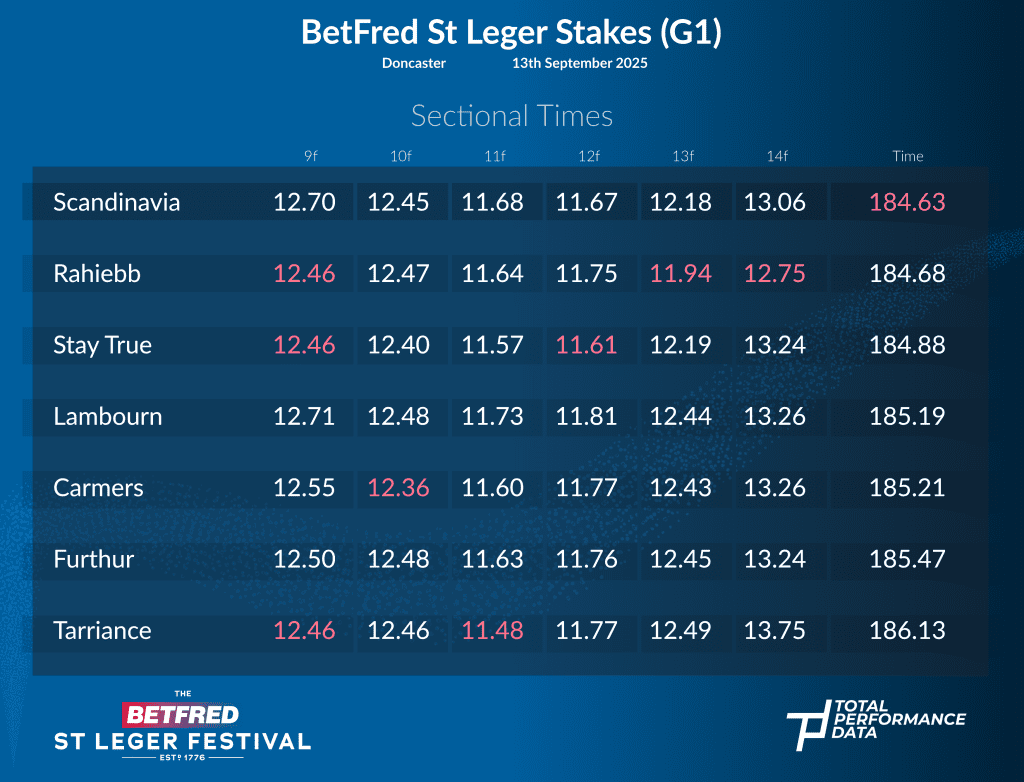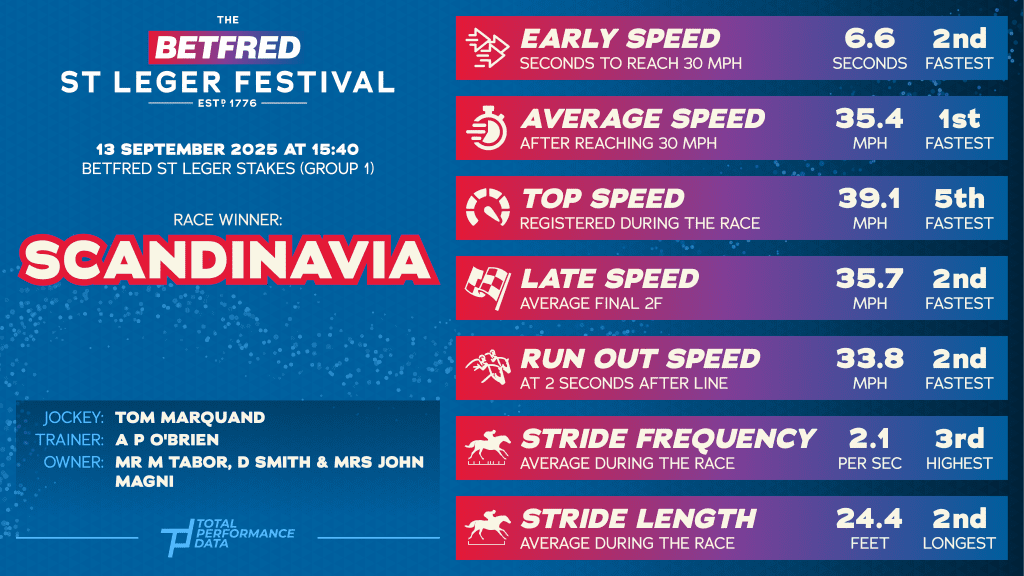BetFred St Leger Stakes (G1)
“Scandinavia”
Having been the Ante Post favourite for this race since July, it was slightly surprising to see that Scandinavia returned an SP of 2/1, but that was perhaps more a reflection of the market support for his stablemate rather than any doubts over his chances. This review should focus on the winner, but I want to deal with Lambourn first. He’s a dual Derby winner and if that had been offered to the team at Ballydoyle at the start of the season with him, I’m sure that they would have been delighted. However, much like in the Great Voltigeur at York, it’s very hard to make an obvious excuse for this performance and having had the run of the race in front, it’s more than a little disappointing that he wasn’t able to sustain his challenge into the latter stages. A winning time of 3:04.63 was over 10s faster than the TPD expected time, but a finishing speed of 103% for the winner, coupled with the fact that the ground would appear to have been quicker than the official “soft” description would suggest that this wasn’t a desperate early gallop and given that both his stride length and stride frequency averages reached their race peaks inside the final 4-furlongs, we can’t really apply the theory that he did too much too soon. There was nothing reported to the Stewards by his connections after the race and there is every possibility that his exertions earlier in the campaign are now taking their toll. However, when we examine the rankings for his closing furlong splits, he ranked 6th, 7th, 7th, 5th and 6th for the final 5-furlongs and he seems unlikely to return to the level of form that he showed earlier in the season at Epsom and the Curragh, certainly not in 2025. That’s the Derby winner covered, now I can move on to the winner and try to make sense of what is a relatively confusing data set.


As you can see from the sectional times above, the first point to note is that there were 4 different horses who ran a fastest furlong split in the home straight at Doncaster and Scandinavia wasn’t one of them. In fact, throughout the entire contest Scandinavia was the fastest horse in just 2 of the 14 furlong splits (4th and 8th furlongs). None of the 7-runners managed to run 3 consecutive fastest furlongs throughout the race and whilst that might lead to the conclusion that this was a stop/start pace, Lambourn appeared to run an even tempo in front, with a variance of just 0.71s between his 3rd and 10th furlongs. The sectional data would certainly lead to the conclusion that there weren’t any hard luck stories and all 7-runners had the opportunity to win the race in the Doncaster straight if they were good enough.


So how does Scandinavia compare to his rivals? Well, with a top speed of 39.1 mph he ranked 5th of 7. That improved to 2nd for this run-out speed (33.8 mph), but it’s important to note that whilst he was driven out through the line with the runner-up on his heels, several of the other jockeys had accepted their fate by that point. His stride frequency average ranked 3rd, as did the time that he took to reach 30 mph from the stalls (6.6s) and at 24.7 ft, his peak average stride length was only 6th of the 7 horses. If you were to ignore the data and purely look at those rankings, it could lead to the conclusion that Scandinavia was a fortunate winner, or at the very least well placed. In fact I think the answer is neither of those points. Tom Marquand had his mount in the right place, but the best word to describe Scandinavia is relentless. What he lacks in class, he more than makes up for with a will to win and a stamina-ladened attitude. It’s not surprising to see that a Goodwood Cup winner stayed on strongly over the St Leger trip, but it was noticeable that Scandinavia was the only horse in the race to increase his average stride length figure over the last 2-furlongs, rising from 24.08 ft (13th) to 24.11 ft (14th). It’s a small increase, but at a time when his rivals were looking for the line, Scandinavia was galloping on. Some might point to the fact that Rahiebb ran the fastest final 2-furlongs and recorded a better run-out speed, but I’d argue the case that he was ridden to do so, having been over half a second behind Scandinavia at the point the race for the line began in the straight.
Having already won a Goodwood Cup as a 3-year-old, Scandinavia will surely be back in 2026 to have a go at the Cup races, but could he win the showpiece Gold Cup at Royal Ascot? The 4-year-olds certainly have a good record in the race, having won it 9 times since 2011 and with the possible exception of Trawlerman, there is nothing to fear in that division. He will need a pacemaker. That’s perhaps a bold statement, but we saw in the Yorkshire Cup last month that Trawlerman can win a race that develops into a sprint (the race had a finishing speed of 107%) and whilst Scandinavia did that in the Goodwood Cup, he was receiving a lot of weight when doing so and that won’t be the case next year. As the data from the St Leger proves, he is unlikely to be swinging on the bridle at the 3-furlong pole in his races and as such, he would be vulnerable in a tactical contest, especially in a small field situation. However, if given the opportunity to build his momentum and get into a late rhythm, he will almost certainly benefit from a return to 2-miles and should at the very least, give Trawlerman something to think about.